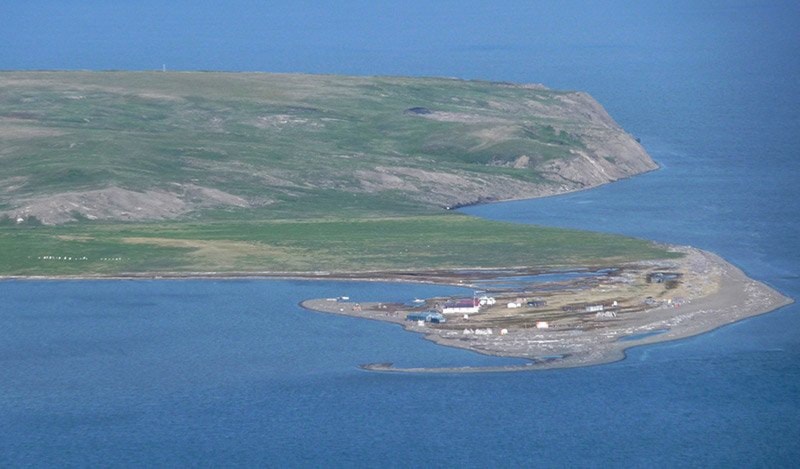Herschel Island has seen a lot of people come and go.
The Inuvialuit have used the place, known as Qikiqtaruk in Inuvialuktun, for at least 1,000 years. They were there, on the island just off of Yukon’s North Slope, when Sir John Franklin landed in 1826 and gave the spot its English name.
In the late 1800s, American whalers built a small colony on the island at Pauline Cove, where they would overwinter to get an early start on the bowhead whale hunt as soon as the ice broke up in the spring. They played baseball to pass the time, even in the depths of winter. In 1897, five men died during a baseball game when a blizzard struck unexpectedly.
But in the early 1900s, the whalebone market collapsed and the whalers moved on.
The North-West Mounted Police set up a detachment on the island in 1903. The Hudson’s Bay Company opened a post there in 1915, but closed it again in 1937, as most residents moved to the Mackenzie Delta. The RCMP detachment finally closed in 1964.
In 1987, Herschel Island was named the Yukon’s first territorial park through the Inuvialuit Final Agreement, to protect its cultural and ecological heritage. Since then, its visitors have largely been researchers, tourists and Inuvialuit from Aklavik and elsewhere.
But 30 years on, the island’s historic legacy is being threatened by taller waves and higher water, which are eating away at shorelines and threatening the 12 remaining buildings at Pauline Cove.
In some places on the island, up to 22 metres of coastline are lost every year, said Michael Fritz, a German researcher who has studied coastal erosion on the island for close to a decade.
Those rates have been increasing as the Arctic climate warms, leaving the ocean open for longer, lengthening the storm season and melting the permafrost that holds the island’s soil together.
“(The permafrost) is really as hard as concrete, but when you thaw it, when you melt out the ice, then it immediately loses its cohesion,” explained Fritz. “So it’s just falling apart, literally, and it all moves down-slope and is washed into the sea.”
Three of the historic buildings have already been moved about 10 metres inland to protect them from the encroaching water, said Barb Hogan, manager of historic sites for the Yukon government.
These days, summer storms can send waves over top of the spit where the dozen buildings are clustered, Hogan explained. It can take a few days for the water to dissipate, leaving the soil around the foundations saturated.
In the next few years, she said, the government plans to lift the buildings up onto cribbing to keep the foundations ventilated and to protect them from rot.
For now, Hogan said, the buildings are largely stable. “But we’re going to be a little bit proactive and just ensure that they remain okay.”
Over the long term, though, it’s unclear what the solution will be. Hogan said climate change forecasts suggest that the sea level around Herschel Island will rise by up to one metre by the end of the century.
If that happens, the buildings might be moved to higher ground on the island. But that’s easier said than done. For one thing, they can’t be moved to an area with permafrost, because the ground disturbance could further melt the permafrost.
There are cultural concerns, too.
“If you move it into another area on the island, you’ve lost its historic context,” Hogan said, explaining that Pauline Cove was chosen for the settlement because it was a protected area where whaling boats could anchor.
She joked that the government might just lift the buildings up higher and let visitors paddle out to see them. “It’ll be the Venice of the North.”
But the changing climate is taking its toll even now. There are graves on the island, both from the whaling colony and the Inuvialuit settlements, that are being unearthed as the permafrost melts. There are also remains of traditional Inuvialuit sod houses near the eroding coast.
Fritz remembers a storm last summer that covered the entire spit at Pauline Cove in water.
“So it’s getting really, really dangerous for some of those locations right now,” he said. “And I would be very, very sad if we would lose these.”
Fritz recently published a paper in the journal Nature Climate Change calling for more research into the impacts of Arctic coastal erosion. He said the research needs to take into account the traditional knowledge of local people who are seeing the changes firsthand.
“If we don’t invest more … we will not be able to create knowledge or to mitigate the very abrupt changes that are happening right now,” he said.
Hogan said she’s visited Herschel Island many times, starting in 2005. She called it a “magical place.”
“There’s whalers graves that are there. The beach is wonderful to walk on. You have a sense of the past when you’re there.”
But that past, increasingly, is under threat.
“I think the site is really important to Yukon and Aklavik history and culture,” Hogan said. “It represents a period of Yukon history. It’s one of a kind and I suspect that we’ll try and do everything in our power to protect it and preserve it.”
Contact Maura Forrest at maura.forrest@yukon-news.com
